Is it safe to clean a refrigerator with bleach?
Our kitchen appliances, especially those involved in storing food, are often cleaned with bleach.
This article explores the effectiveness, potential risks, and precautions of cleaning refrigerators with bleach.
To keep your refrigerator clean and safe, learn the dos and don’ts of refrigerator cleaning.
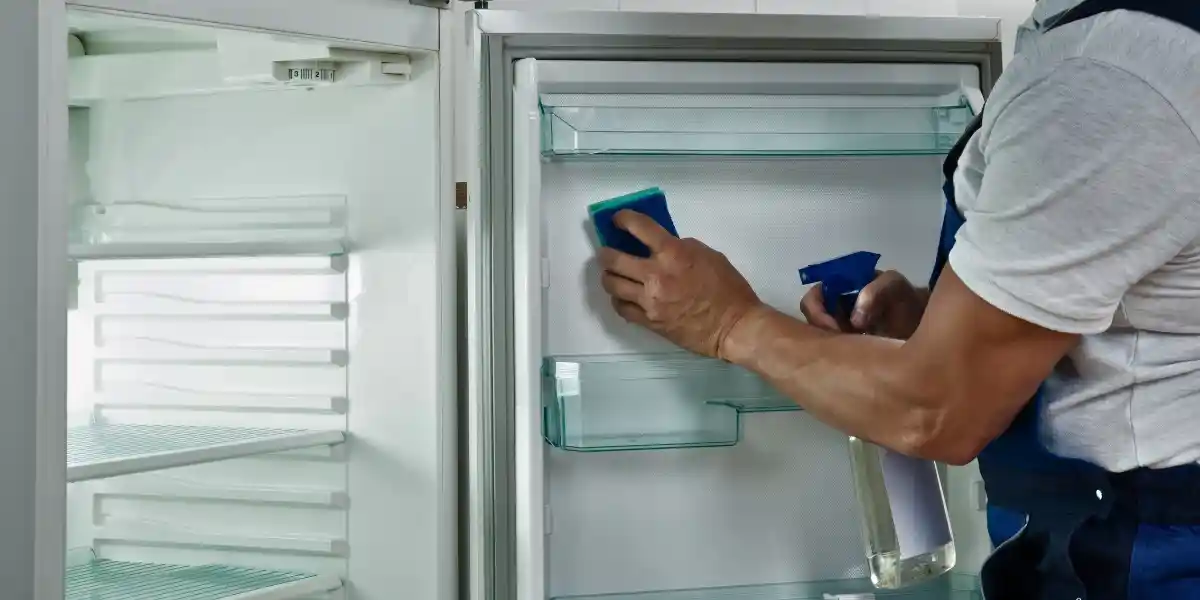
Is It Safe to Clean a Refrigerator with Bleach?
Yes, it is safe to clean a refrigerator with bleach. Bleach is effective in killing germs and sanitizing surfaces.
Use it properly, dilute it correctly, and ensure thorough rinsing to avoid any lingering residue.
Benefits of Using Bleach for Refrigerator Cleaning
Using bleach for cleaning your refrigerator has a number of benefits. They are,
Effective and Powerful Cleaning:
When it comes to cleaning your refrigerator, using bleach can be highly beneficial. The powerful cleaning properties of bleach make it an excellent choice for removing stubborn stains.
With sodium hypochlorite as its active ingredient, your refrigerator stays hygienic and spotless.
Disinfection and Sanitization:
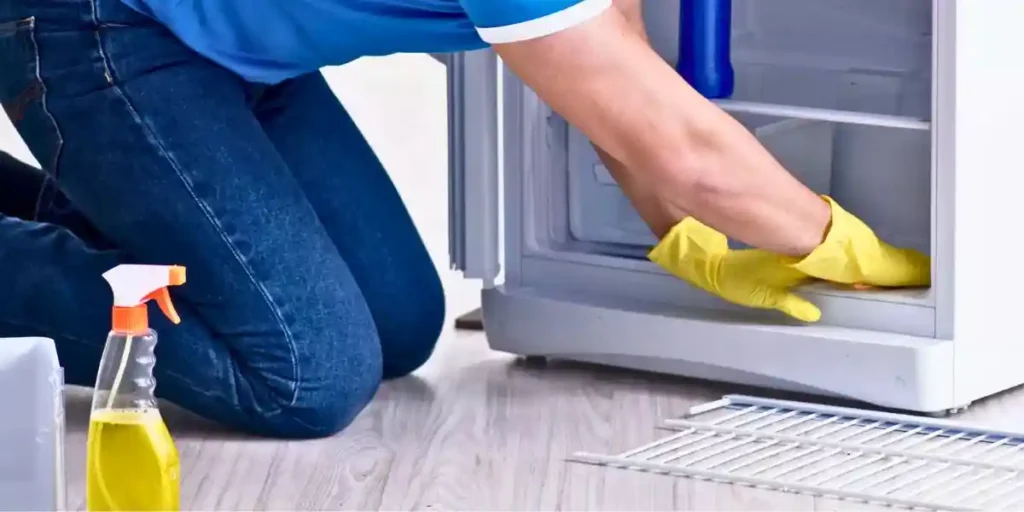
The ability of bleach to disinfect and sanitize refrigerators is one of its major advantages.
In addition to killing E. coli, salmonella, and staphylococcus, bleach is a powerful disinfectant.
You can prevent food contamination and spoilage by using bleach in your cleaning routine.
Odor Elimination:
Refrigerators often develop unpleasant odors due to food spills or the growth of mold and mildew.
Bleach’s strong scent-fighting properties can help eliminate these unwanted smells effectively.
Use a diluted bleach solution to clean the interior surfaces of your refrigerator and neutralize odors.
Mold and Mildew Prevention:
A refrigerator’s moist and dark environment can promote mold growth and compromise food safety.
Bleach is highly effective in preventing the growth of mold and mildew due to its ability to kill spores.
Maintain a healthy and safer refrigerator environment by regularly cleaning with a bleach solution.
Stain Removal:
Bleach is known for its remarkable stain-removing capabilities. You can break down tough stains, such as those from food spills, with diluted bleach solutions.
If you want to restore the pristine appearance of your refrigerator, bleach can be a great ally.
Affordable and Readily Available:
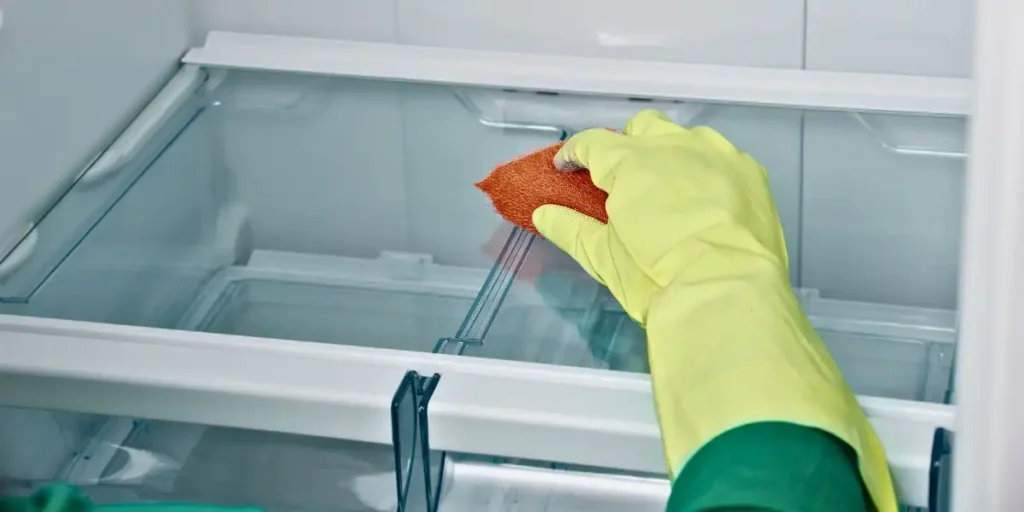
Another advantage of using bleach for refrigerator cleaning is its affordability and wide availability. Cleaning with bleach is a cost-effective and accessible option available at grocery stores.
Your refrigerator can be thoroughly cleaned without breaking the bank using just bleach and water.
Versatile Cleaning Agent:
Bleach can also be used for other cleaning tasks around the house besides refrigerator cleaning.
Bleach provides a range of benefits, from disinfecting countertops to removing stains from clothing.
By having bleach on hand, you can tackle multiple cleaning challenges efficiently and effortlessly.
Risks and Precautions when Cleaning a Refrigerator with Bleach
Here are some important points to consider:
Ventilation:
Bleach emits strong fumes that can be irritating to the respiratory system. It is crucial to work in a well-ventilated area when using bleach to clean your refrigerator.
Allow fresh air to circulate or turn on exhaust fans to prevent fumes from building up. You can further protect yourself from inhaling the fumes by wearing a mask or respirator.
Protective Clothing:
Wear protective clothing, including gloves and long sleeves, when handling bleach. This prevents direct contact with the bleach solution, which can cause skin irritation or burns.
Wearing protective eyewear can safeguard your eyes from potential splashes or accidental exposure.
Avoid Mixing:
Cleaning products containing ammonia or acidic substances should never be mixed with bleach.
Mixing bleach with these chemicals can create toxic fumes and pose severe health risks.
Make sure you read the label of cleaning products and follow the instructions to ensure safety.
Dilution:
Bleach is highly concentrated and should be diluted before use. Mix bleach with water according to the instructions when cleaning your refrigerator.
A solution of one part bleach to ten parts water is sufficient for effective cleaning. Using undiluted bleach can damage surfaces, release stronger fumes, and increase the risk of accidents.
Avoid Contact with Food:
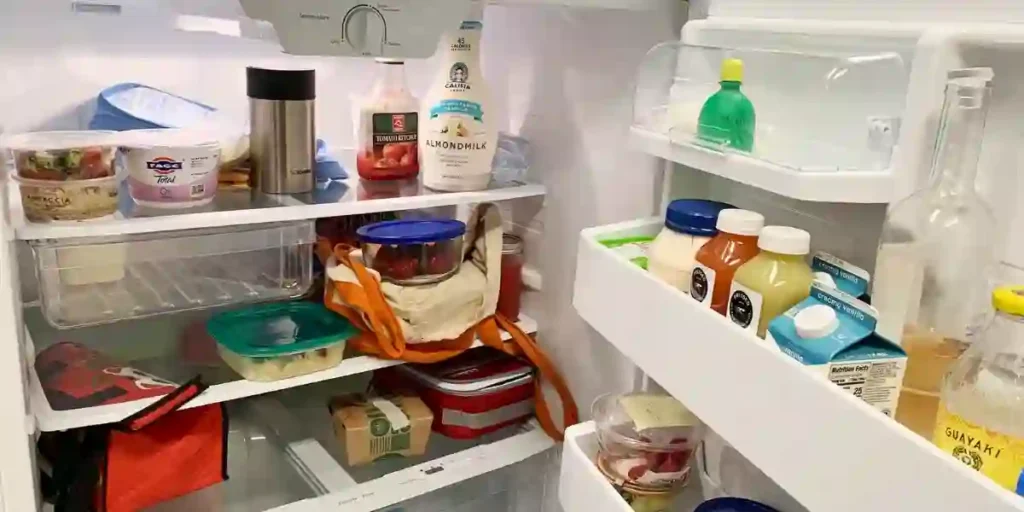
All food items should be removed from the refrigerator before you use bleach to clean it. Potential health hazards can arise from accidental contact between bleach and food.
Remove any residual bleach from the refrigerator surfaces by thoroughly rinsing them with water.
Follow Instructions:
Always read and follow the instructions provided on the bleach bottle or packaging.
Specific bleach product guidelines may include contact times, surfaces, and safety precautions.
Adhering to these instructions will help ensure effective cleaning while minimizing risks.
Test on Surfaces:
If you plan to use bleach throughout your refrigerator, test it on a small, inconspicuous area first.
To determine if the bleach solution causes any adverse reactions or damage to the surface.
Consider alternative cleaning methods or consult the manufacturer if negative effects occur.
Proper Disposal:
After completing the cleaning process, dispose of any remaining bleach solution properly.
Bleach can contaminate water and harm the environment if poured down the drain or toilet.
Use a sink connected to a municipal wastewater treatment system to drain the remaining solution.
How to Safely Clean a Refrigerator with Bleach: Step-by-Step Guide
Follow these steps to safely and efficiently clean your refrigerator using bleach:
Step 1: Gather Your Supplies
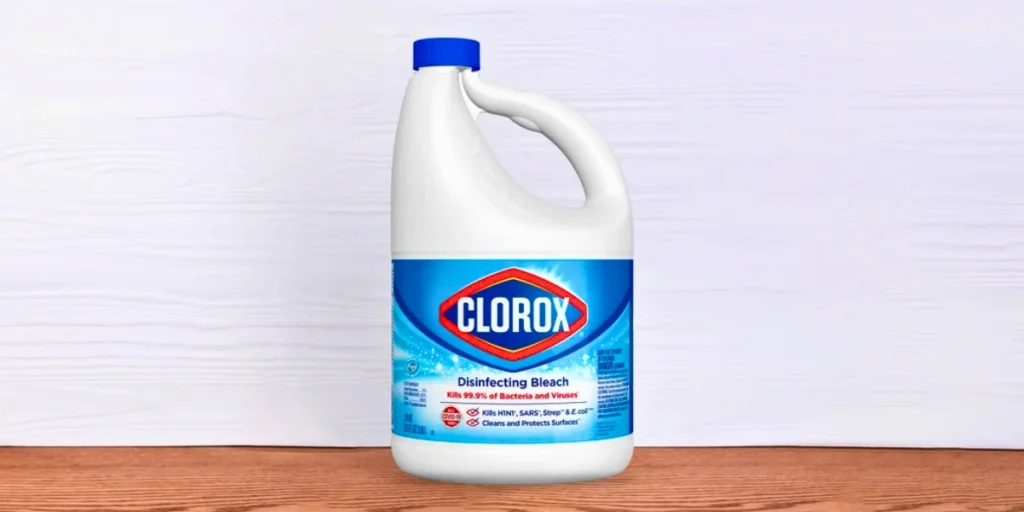
Before starting the cleaning process, gather all the necessary supplies. You will need:
Bleach:
Choose a bleach product that contains sodium hypochlorite as the active ingredient.
Water:
Ensure you have access to clean water for diluting the bleach solution and rinsing.
Gloves:
Wear protective gloves to prevent direct contact between your skin and the bleach solution.
Cleaning Cloth or Sponge:
Select a cloth or sponge that is suitable for scrubbing and wiping down surfaces.
Mask or Respirator (optional):
If you are sensitive to bleach fumes, consider wearing a mask or respirator for added protection.
Protective Eyewear (optional):
Safeguard your eyes from accidental splashes by wearing protective eyewear.
Step 2: Empty and Prepare the Refrigerator
Remove all food items from your refrigerator and store them in a cool place. Dispose of any expired or spoiled items.
Take out any removable shelves, drawers, and trays, and set them aside for separate cleaning.
Step 3: Dilute the Bleach Solution
Follow the instructions on the bleach bottle to determine the appropriate ratio for diluting the bleach.
A solution of one part bleach to ten parts water is recommended for refrigerator cleaning. Prepare the solution in a bucket or spray bottle, ensuring it is thoroughly mixed.
Step 4: Clean the Interior Surfaces
Dip the cleaning cloth or sponge into the diluted bleach solution and wring out any excess liquid.
Wipe down the walls, shelves, and drawers of the refrigerator starting from the top.
Pay close attention to areas with stains, spills, or visible dirt. Scrub gently but thoroughly to remove any grime or residue.
Step 5: Focus on Stubborn Stains and Spills
For stubborn stains or spills, apply the diluted bleach solution directly to the affected area. Allow the solution to sit for a few minutes to break down the stain.
Then, use a cloth or sponge to scrub the area until the stain is removed. Rinse the cloth or sponge frequently and reapply the bleach solution as needed.
Step 6: Clean Removable Shelves and Drawers
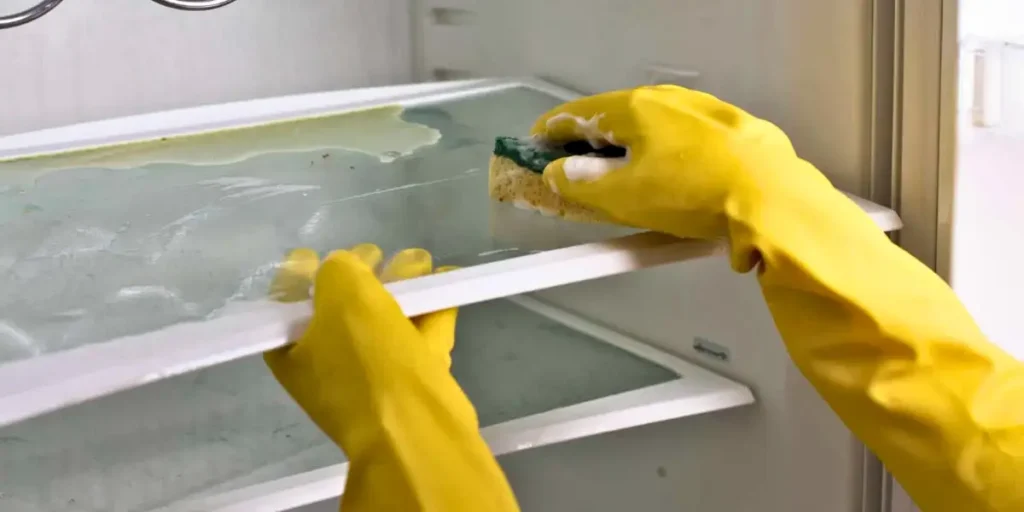
Take the shelves, drawers, and trays that were set aside and clean them separately. Submerge them in a basin or sink filled with the diluted bleach solution.
Allow them to soak for a few minutes, then scrub them with a cloth or sponge.
Place them back in the refrigerator after thoroughly rinsing them with water and letting them air dry.
Step 7: Rinse the Interior Surfaces
After cleaning, rinse the interior surfaces of the refrigerator with clean water. Use a damp cloth or sponge to wipe away any remaining bleach solution.
Ensure that no bleach residue remains, as it can be harmful if it comes into contact with food.
Step 8: Ventilate and Dry
To remove any remaining bleach fumes, open windows or turn on exhaust fans. Allow the refrigerator to air dry for a while before returning the shelves, drawers, and trays.
Ensure that all surfaces are completely dry to prevent the growth of mold or mildew.
Step 9: Return Food Items
Once the refrigerator is completely dry, you can return the food items to their designated places.
Ensure that all food containers are sealed properly and organized for easy access.
Alternatives to Bleach for Cleaning Your Refrigerator
Here are some alternatives to bleach for cleaning your refrigerator:
Vinegar:
Clean and disinfect your refrigerator with vinegar, a versatile and natural cleaning agent. Its acidic properties help break down dirt, grime, and odors.
Mix equal parts of white vinegar and water in a spray bottle. Spray the solution onto the surfaces of your refrigerator, including shelves, drawers, and walls.
Wipe with a cloth or sponge and rinse with clean water afterward.
Baking Soda:
You can use baking soda to eliminate odors in your refrigerator due to its deodorizing properties. Create a paste by mixing baking soda with water.
Apply the paste to stubborn stains or spills, and gently scrub with a cloth or sponge. Baking soda can also be used to absorb odors in the refrigerator.
Place an open container of baking soda on a shelf to absorb unwanted smells.
Hydrogen Peroxide:
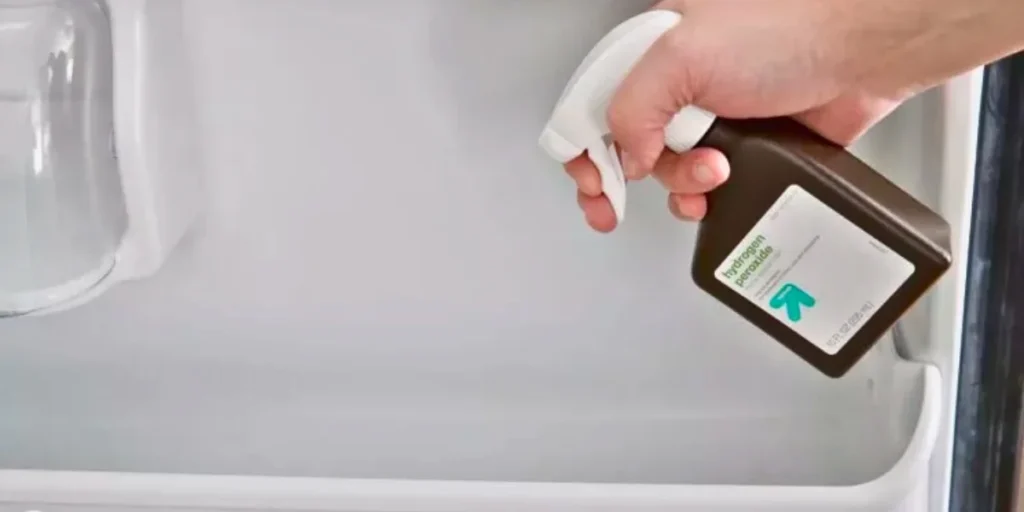
Hydrogen peroxide is a mild disinfectant that can be used to clean and sanitize your refrigerator. It effectively kills bacteria and eliminates odors.
Dilute hydrogen peroxide with water in a spray bottle and apply it to the surfaces of your refrigerator.
Allow it to sit for a few minutes, then wipe it with a cloth or sponge. Rinse with clean water afterward.
Lemon Juice:
Stains and odors can be effectively removed with lemon juice, a natural cleaning agent. Mix equal parts of lemon juice and water in a spray bottle.
Spray the solution onto the refrigerator surfaces and let it sit for a few minutes. Wipe with a cloth or sponge and rinse with clean water.
The acidic nature of lemon juice helps break down dirt and grime.
Dish Soap:
Dish soap is a gentle yet effective cleaner that can be used for general refrigerator cleaning. Dilute a small amount of dish soap in a bucket of warm water.
Dip a cloth or sponge into the soapy solution and wipe down the refrigerator surfaces.
Focus on areas with stains or spills. Rinse the cloth or sponge frequently and change the water as needed.
Commercial Natural Cleaners:
Commercial cleaning products specifically formulated for refrigerators are available. Look for natural and eco-friendly options that are free from harsh chemicals.
Read the product labels for usage instructions and follow them carefully.
FAQs about Cleaning Refrigerators with Bleach
Can Bleach Completely Eliminate Odors In The Refrigerator?
Bleach can help eliminate many odors in the refrigerator due to its strong disinfecting properties. It may be necessary to use additional odor removal methods for strong or persistent odors.
In addition to cleaning, baking soda, activated charcoal, or other natural odor absorbers can be used.
Is Bleach The Only Option For Disinfecting A Refrigerator?
No, bleach is not the only option for disinfecting a refrigerator. There are alternative cleaning agents available that can effectively sanitize and disinfect. As an alternative to bleach, vinegar is a natural and effective disinfectant.
Hydrogen peroxide is another option that possesses disinfecting properties. These alternatives are particularly useful for those who want to avoid bleach or are sensitive to it.
Can Bleach Residue Be Harmful If It Comes Into Contact With Food?
Yes, bleach residue can be harmful if it comes into contact with food. After cleaning with bleach, rinsing the refrigerator with clean water is crucial to ensuring food safety.
This step removes any residual bleach and prevents any potential contamination of food items.
Conclusion
Keep your refrigerator clean and fresh by safely using bleach for cleaning. Clean surfaces safely by diluting bleach properly, following safety guidelines, and rinsing thoroughly.
With its effectiveness in stain removal, disinfection, and odor elimination, bleach is a reliable option.
Vinegar, baking soda, and hydrogen peroxide are also safe and effective alternatives.
